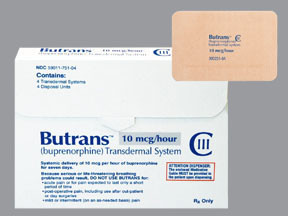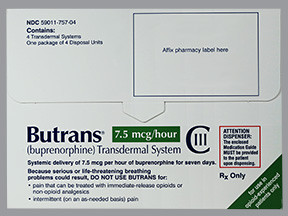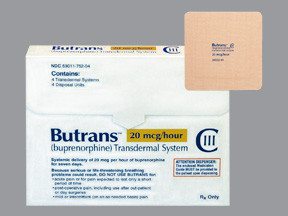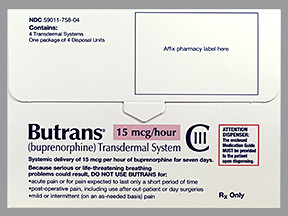BUPRENORPHINE - TRANSDERMAL
PHONETIC PRONUNCIATION: (BUE-pre-NOR-feen)
COMMON BRAND NAME(S): Butrans
GENERIC NAME(S): buprenorphine
Uses
USES: This medication is used to help relieve severe ongoing pain (such as due to arthritis, chronic back pain). Buprenorphine belongs to a class of drugs known as opioid (narcotic) analgesics. It works in the brain to change how your body feels and responds to pain. The higher strengths of this drug (7.5, 10, 15, or 20 micrograms per hour patches) should be used only if you have been regularly taking moderate amounts of opioid pain medication. These strengths may cause overdose (even death) if used by a person who has not been regularly taking opioids. Do not use this medication to relieve pain that is mild or that will go away in a few days. This medication is not for occasional ("as needed") use.
How to use BUPRENORPHINE - TRANSDERMAL
HOW TO USE: See also Warning section. Read the Medication Guide and, if available, the Patient Information Leaflet provided by your pharmacist before you start using this medication and each time you get a refill. Learn how to properly use, store, and discard the patches. If you have any questions, ask your doctor or pharmacist. Use this medication on a regular schedule as directed by your doctor, not as needed for sudden (breakthrough) pain. If you are already using an opioid medication, ask your doctor or pharmacist if you should stop or change how you use your other opioid medication. It may take 24 hours or longer before you have pain relief from buprenorphine patches. Other pain relievers (such as acetaminophen, ibuprofen) may also be prescribed. Ask your doctor or pharmacist about using buprenorphine safely with other drugs. Apply this medication to the skin as directed by your doctor. Do not apply on burns, cuts, irritated skin, or skin that has been exposed to radiation (x-ray treatment). Select a dry, non-hairy area on a flat part of your body, such as the upper chest, sides of the chest, upper back, or upper outer arms. In people unable to think clearly (such as due to dementia), apply the patch on the upper back to lessen the chance it might be removed or placed in the mouth. If there is hair on the skin, use scissors to clip the hair as close as possible to the skin. Do not shave hair since this might cause skin irritation. If needed, use water to clean the area. Do not use soap, oils, lotions, or alcohol on the application site. Dry the skin well before applying the patch. The patch is usually changed every 7 days. To avoid irritation, apply to a different area each time and do not apply to the same site within 3 weeks. Be sure to remove the old patch before applying a new patch. The used patch should be folded in half with the sticky sides together and properly discarded. If your manufacturer has supplied a patch disposal unit, follow directions for its use. Do not use the patch if it appears to be broken, cut, or damaged. Remove from the sealed pouch, peel off the protective liner, and apply right away to the skin. Press firmly in place with the palm of the hand for about 15 to 30 seconds, making sure the contact is complete (especially around the edges). If your prescribed dose is for more than one patch, apply them right next to each other but make sure the edges of the patches do not touch or overlap. After applying the patch, wash your hands with water only. You may bathe, shower, or swim while wearing the patch. If you have problems with the patch not sticking at the application site, you may tape the edges in place with certain kinds of first aid tape. Ask your doctor or pharmacist about which type of tape should be used. If this problem persists, ask your doctor for advice. If the patch falls off before 7 days, a new patch may be applied to a different skin site. Be sure to let your doctor know if this happens. If you accidentally touch the sticky layer to your skin or handle a cut or damaged patch, wash the area well with clear water. If the patch comes off and accidentally sticks to the skin of another person, immediately remove the patch, wash the area with water, and get medical help for them right away. Do not use soap, alcohol, or other products to wash the area. The dosage is based on your medical condition and response to treatment. Do not apply more patches than directed, change them more frequently, or use them for a longer time than prescribed. Your risk for side effects will increase. This medication may cause withdrawal reactions, especially if it has been used regularly for a long time or in high doses. Withdrawal can also occur if you are switching from another opioid medication to buprenorphine. Symptoms of withdrawal include restlessness, watering eyes, runny nose, nausea, sweating, or muscle aches. To prevent withdrawal reactions, your doctor may reduce your dose gradually. Ask your doctor or pharmacist for more details, and report any withdrawal reactions right away. When this medication is used for a long time, it may not work as well. Talk with your doctor if this medication stops working well. Though it helps many people, this medication may sometimes cause addiction. This risk may be higher if you have a substance use disorder (such as overuse of or addiction to drugs/alcohol). Use this medication exactly as prescribed to lower the risk of addiction. Ask your doctor or pharmacist for more details. Tell your doctor if your pain is not relieved or if it worsens.
Side Effects
Precautions
Interactions
Overdose
Images

- color
- beige
- shape
- rectangle
- imprint
- Butrans 10mcg/hour

- color
- beige
- shape
- rectangle
- imprint
- Butrans 7.5 mcg/hour
Reviews
Warning
WARNING: Buprenorphine has a risk for abuse and addiction, which can lead to overdose and death. Buprenorphine may also cause severe, possibly fatal, breathing problems. To lower your risk, your doctor should have you use the smallest dose of buprenorphine that works, and use it for the shortest possible time. See also How to Use section for more information about addiction. The risk for severe breathing problems is higher when you start this medication and after a dose increase, or if you use the wrong dose/strength or misuse the medication (such as chewing or swallowing the patch). Using this medication with alcohol or other drugs that can cause drowsiness or breathing problems may cause very serious side effects, including death. Be sure you know how to use buprenorphine and what other drugs you should avoid taking with it. See also Drug Interactions section. Get medical help right away if any of these very serious side effects occur: slow/shallow breathing, unusual lightheadedness, severe drowsiness/dizziness, difficulty waking up. Keep this medicine in a safe place to prevent theft, misuse, or abuse. If someone accidentally swallows or uses this drug, get medical help right away because fatal breathing problems may occur. Before using this medication, women of childbearing age should talk with their doctor(s) about the risks and benefits. Tell your doctor if you are pregnant or if you plan to become pregnant. During pregnancy, this medication should be used only when clearly needed. It may slightly increase the risk of birth defects if used during the first two months of pregnancy. Also, using it for a long time or in high doses near the expected delivery date may harm the unborn baby. To lessen the risk, use the smallest effective dose for the shortest possible time. Babies born to mothers who use this drug for a long time may develop severe (possibly fatal) withdrawal symptoms. Tell the doctor right away if you notice any symptoms in your newborn baby such as crying that doesn't stop, slow/shallow breathing, irritability, shaking, vomiting, diarrhea, poor feeding, or difficulty gaining weight.
Disclaimer
IMPORTANT: HOW TO USE THIS INFORMATION: This is a summary and does NOT have all possible information about this product. This information does not assure that this product is safe, effective, or appropriate for you. This information is not individual medical advice and does not substitute for the advice of your health care professional. Always ask your health care professional for complete information about this product and your specific health needs.



No Reviews Yet